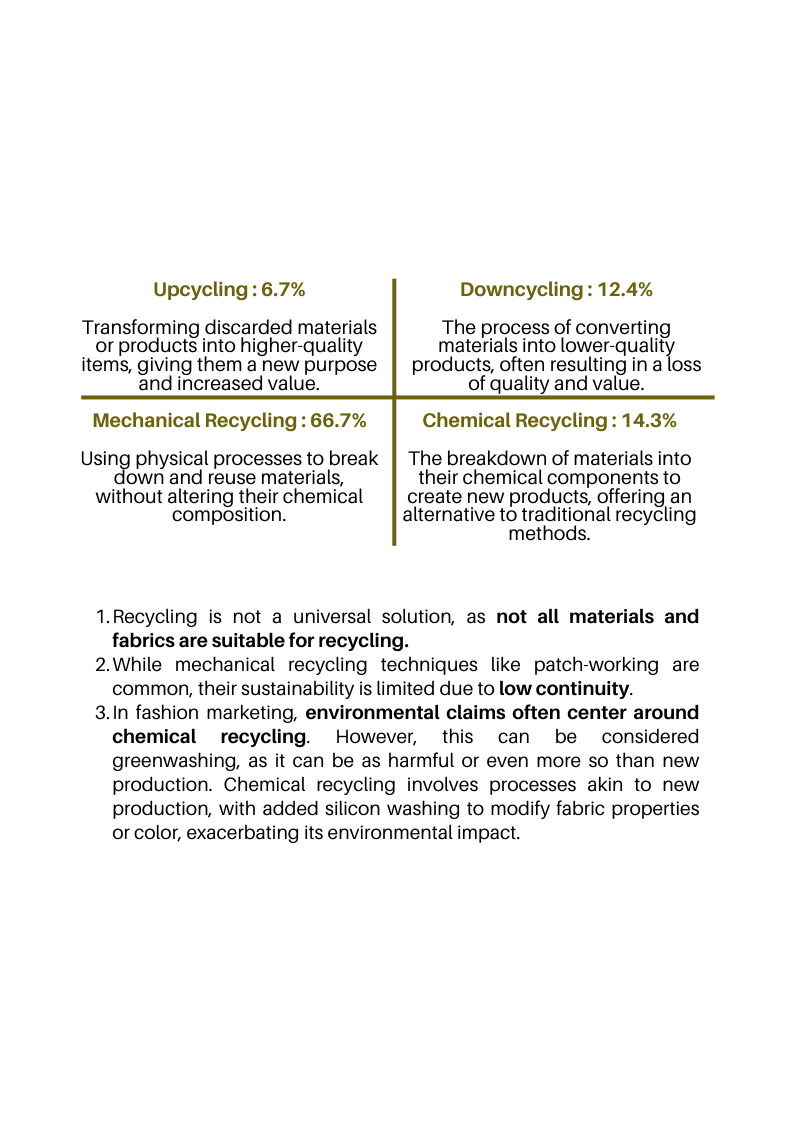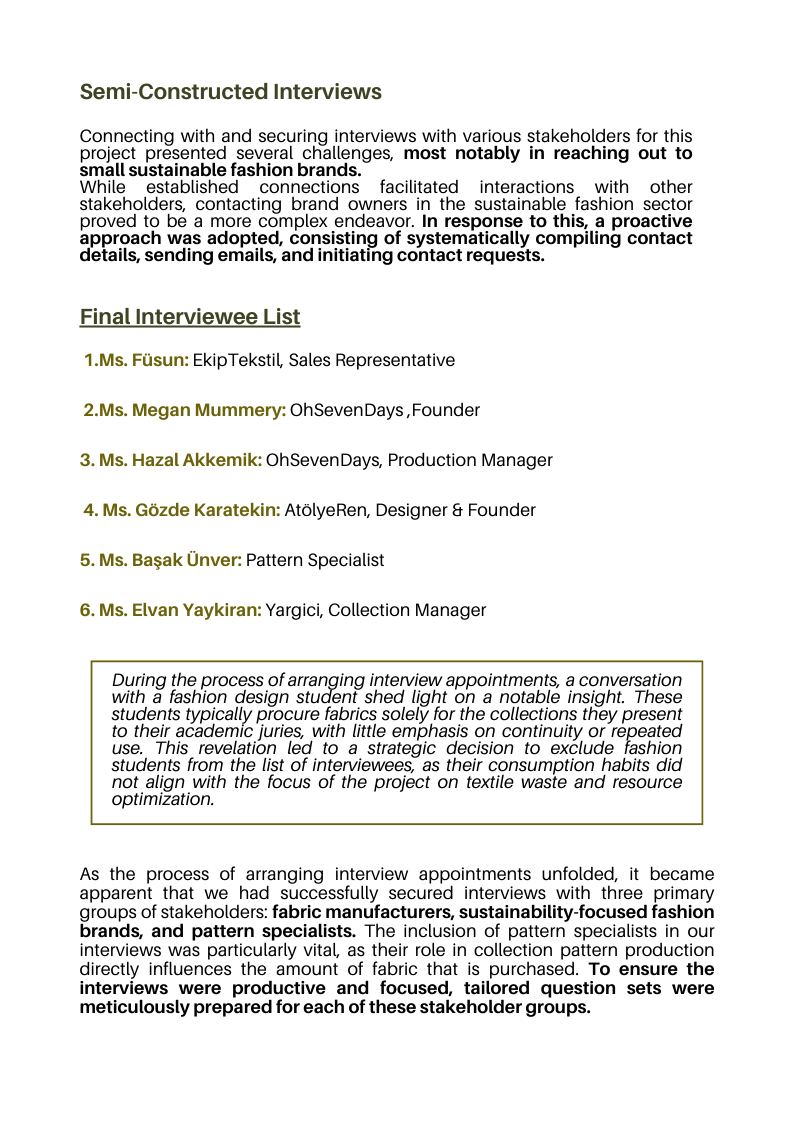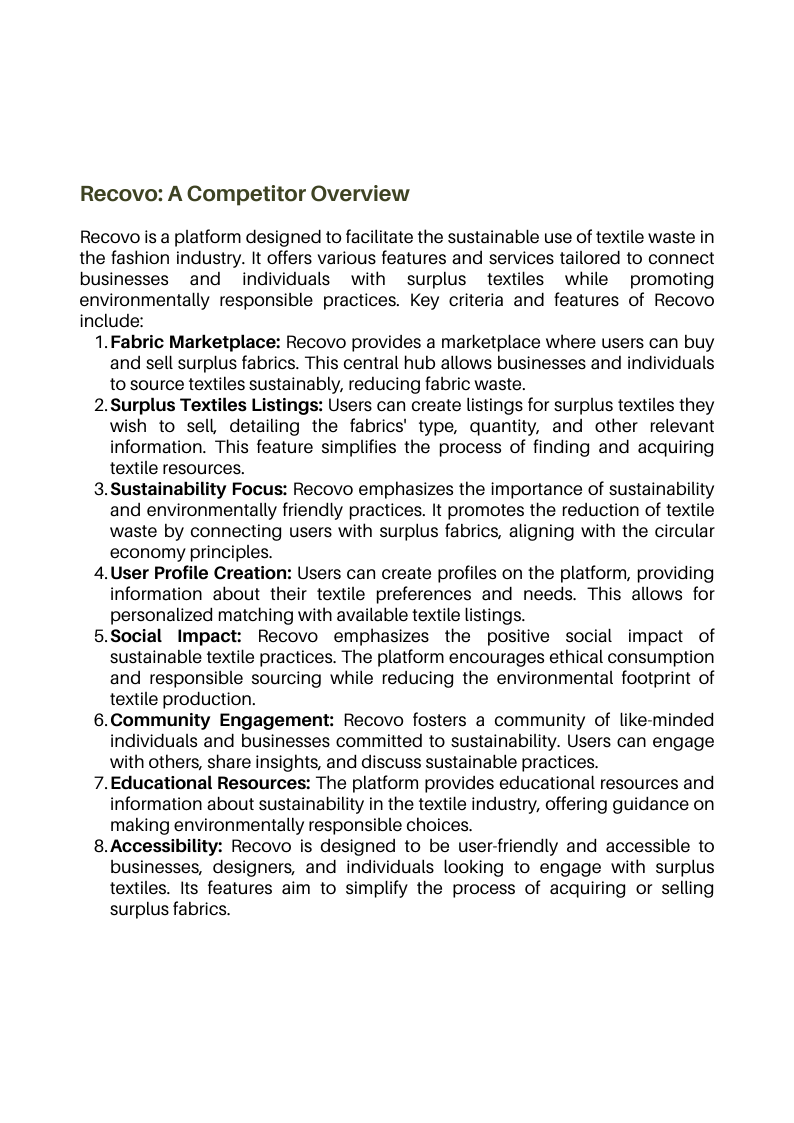UX Research
During the ReTreasure project, I engaged in extensive collaboration with numerous manufacturers, retailers, and small business owners based in Turkey. In addition to primary research with industry professionals, I conducted comprehensive desk research to gather essential insights and data. Furthermore, I sought feedback from a dedicated research team consisting of master's and Ph.D. students, ensuring a well-rounded and data-driven approach to the project. This multidimensional collaboration and the variety of data sources enriched the quality and depth of my research and design work.
Desk Research
Research Findings on Drivers and Barriers of Adoption of Circular Economy (CE) in the Textile and Apparel Industry
Recycling: Is it really the BEST option or Greenwashing?
Hence, the core issue at the heart of my project took shape around residual fabrics.
Despite the environmental and production risks associated with fabric production, the industry continues to generate excessive quantities even when there's an existing surplus.
The primary reason behind this paradox is the lack of effective and high-quality communication between fashion brands and businesses and the manufacturers and retailers in the industry.
This deficiency in communication has led to inefficiencies and excess fabric production.
Exploratory Research
Semi-Constructed Interviews Key Takeaways:
Residual Fabrics and Excessive Production: Many fabrics have a short lifespan in the fashion industry, typically lasting only one or two seasons, leading to an accumulation of what is now referred to as residual fabrics, or the result of excessive production.
Challenges in Connecting with the Right Consumers: Distributing these residual fabrics to the appropriate consumers is a time-consuming process. Customer service representatives often engage in one-on-one conversations with potential buyers, which is resource-intensive.
Potential for Collaboration: Large fabric vendors express their willingness to collaborate with fashion students, recognizing the value of such partnerships if the opportunity arises.
The Need for Infrastructure: Stakeholders indicate a desire for an infrastructure or client profile index that can streamline the process of connecting leftover fabrics with interested parties. This would save time and resources.
Hurdles in Sustainability: Companies dedicated to "slow and sustainable fashion" aim to assess the volume of leftover fabrics in Turkey. However, they face challenges in identifying and connecting with potential suppliers. The current approach involves individual emails, travel expenses, and uncertainty regarding the outcomes, making the process less efficient and sustainable.
Why UN Initiatives did not work in Turkey?
The UN initiative's experience in Turkey highlighted the importance of building trust within the textile industry. This case served as a valuable lesson for my project, emphasizing the need to develop a systematic solution that addresses the trust barrier.
As I continued to work on ReTreasure, these insights played a crucial role in shaping the project's approach and strategy. By understanding the challenges faced by the UN initiative, I aimed to create a platform that not only connects businesses with residual fabrics but also instills trust and confidence in the process.
Competitor Analysis
In the quest to understand the competitive landscape and refine the ReTreasure project, I conducted extensive research to identify market competitors that closely align with my project's goals and objectives. While desk research had initially uncovered various platforms, I sought to validate their relevance by discovering competitors used by potential target users. This research led me to a foreign competitor known as Recovo. In evaluating Recovo's features and offerings, I aimed to discern the main criteria that would help me make informed decisions and enhance the development of ReTreasure.
Understanding the criteria and features of Recovo allowed me to gain insights into how existing platforms approach sustainable textile practices. These findings were invaluable in shaping the development of ReTreasure to meet the needs and expectations of potential users and address the specific challenges faced by small and sustainable fashion brands and manufacturers.
Choosing the Mobile App Path: Expanding Design Horizons
During the course of my exploratory research and the analysis of competitors like Recovo, I recognized the need to differentiate ReTreasure by highlighting specific features and optimizing user interface design. As a pivotal strategic decision, I chose to develop ReTreasure as a mobile application, rather than a website.
By opting to develop an app for ReTreasure, I embraced the design challenge of creating an intuitive and user-friendly interface, elevating the user experience to new heights. This decision reflects the project's commitment to meeting the needs and preferences of its users while tackling the challenges of the textile industry's circular economy.
Project Goal Statement
-
The textile and fashion industry generates a substantial amount of residual fabrics, which often go to waste due to inadequate connections between small sustainable fashion businesses and manufacturers/retailers. These unused fabrics are polluting the environment, and there's a lack of efficient systems to ensure their reuse.
-
Small sustainable fashion brands, fabric manufacturers, pattern specialists, and retailers in the textile and fashion industry.
-
Addressing this issue is crucial for promoting sustainability in the fashion industry, reducing environmental pollution, and improving resource efficiency. Small businesses can benefit from cost-effective, sustainable fabric sourcing, while manufacturers can make better use of their surplus materials.
-
ReTreasure, a B2B e-commerce app, aims to connect small sustainable fashion brands, fabric manufacturers, and retailers to make efficient use of residual fabrics. The app will provide a platform for sharing information, facilitating transactions, and fostering a circular economy in the textile industry. It will help reduce waste, promote sustainability, and improve the business practices of all stakeholders involved.







